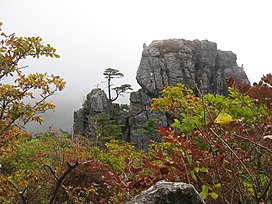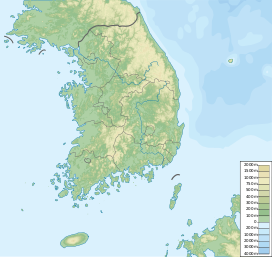
Back Чирисан Bulgarian Jirisan Catalan Čirisan Czech Jirisan German Jirisan Spanish جیریسان Persian Jirisan French Gunung Jiri ID Jirisan Italian 智異山 Japanese
You can help expand this article with text translated from the corresponding article in Korean. (March 2022) Click [show] for important translation instructions.
|
| Jirisan | |
|---|---|
 | |
| Highest point | |
| Elevation | 1,915 m (6,283 ft)[1] |
| Prominence | 1,696 m (5,564 ft) |
| Listing | Ultra, Ribu |
| Coordinates | 35°20′13″N 127°43′50″E / 35.33694°N 127.73056°E |
| Geography | |
| Parent range | Sobaek Mountains |
| Climbing | |
| Easiest route | Hike |
| Korean name | |
| Hangul | 지리산 |
| Hanja | |
| Revised Romanization | Jirisan |
| McCune–Reischauer | Chirisan |
Jirisan (Korean: 지리산) is a mountain located in the southern region of South Korea. It is the second-tallest mountain in South Korea after Jeju Island's Hallasan, and is the tallest mountain in mainland South Korea.[2]
The 1915m-high mountain is located in Jirisan National Park. The park spans three provinces (North, South Jeolla and South Gyeongsang) and it is the largest in South Korea. The largest proportion of the national park is in the province of South Gyeongsang. The highest peak of the mountain, Cheonwangbong is also located in this province. Another well-known peak is Samsinbong (Three Spirits Peak).
Jirisan is at the southern end of the Sobaek and Baekdu-daegan mountain ranges, the "spine" of the Korean Peninsula incorporating the Sobaek mountain range and most of the Taebaek mountain range.
There are seven major Buddhist temples on Jirisan. Hwaeomsa is the largest and best-known temple among these. It contains several national treasures, mostly stone artworks from about 600–900 CE. The mountain is also home to the Cheonghak-dong (Azure Crane Village) alpine valley, which includes the Samseonggung (Three Sages Palace), which is a site celebrating one of Korea's foundation myths.[3]
Every year more than 280,000 people visit Jirisan. Summer and autumn are the most popular visiting seasons. The mountain is advertised as having ten scenic views. These are ‘Sunrise from Cheonwang-bong peak’, ‘Nogodan Sea of Clouds’, ‘Banyabong’s Nakjo’, ‘Full moon at Byukso-ryung’, ‘Piagol Autumn Leaves’, ‘Royal Azalea Blossoming’, ‘Chilseon Valley’, ‘Seomjincheongryu’, ‘Buril water fall’, ‘Yeonha-Sunkyung’. Jirisan National Park has several hiking routes.
- ^ https://peakbagger.com/peak.aspx?pid=10766
- ^ "Highest Mountains South Korea". www.geonames.org.
- ^ "지리산" (in Korean). Retrieved 2018-06-14.
